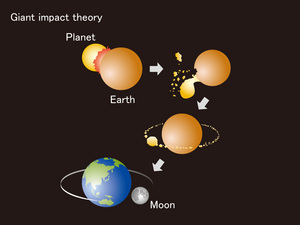Nagoya City Science Museum
TOP > Exhibition Guide > Floor Map> Phases of the Moon
Phases of the Moon



Purpose of Exhibition
The moon is the only natural satellite that revolves around the earth. The moonlight was much more precious to us at night in the days before street lamps, and the moon was so familiar that its periodic phases were used as the basis for the calendar.
The moon is illuminated by the sun, that is, it does not shine by itself, so only half of the moon is always bright. And since the moon orbits the earth, the moon appears to change shape depending on the angle from which the earth is looking at the lit part of the moon. The moon goes through a cycle of phases: new moon, waxing moon, full moon, waning moon, and returns to its original shape in almost a month (about 29.5 days).
This exhibit will show you how the lunar phases work with two devices: a rotating moon globe and a model of the earth and moon which are based on data from the lunar orbiter KAGUYA.
Additional Knowledge
[Old Japanese Names for Moon Phases]
We have given various names to the phases of the moon throughout the ages. Based on the lunar calendar, the moon on the 1st is called "Shingetsu” (New Moon), on the 3rd “Mikazuki” (literally, 3rd Day’s Moon), and on the 15th “Juugoya no Tsuki” (15th Night’s Moon), which is often a full moon. The 16th night’s moon “Izayoi” means “hesitation.” It describes the 16th moon rising later than the full moon, that is, the moon is hesitant to come. “Tachimachi no Tsuki” is on the 17th day; you wait standing for a while, and the moon will appear. The 18th “Imachi no Tsuki”; you may want to sit down to wait. The 19th “Nemachi no Tsuki”; you lie down and might be at rest until the moon come out. The 20th “Fukemachi no Tsuki”; as the night goes on, and the moon will show up sooner or later. “Ariake no Tsuki” refers to the moon that you can see still at dawn, and is later than the 16th night moon.
[How did the Moon Come to Be?]
There are several possible origins of the moon. The Fission Theory says that a part of the earth was torn off to form the moon. The Condensation Theory suggests that the moon was created along with the earth. The Capture Theory states that the earth caught the moon from elsewhere in the solar system. These theories can indeed explain some of the moon’s properties, but not all of them.
Currently, the “Giant Impact Theory” is the most prevailing theory; at the dawn of the solar system, a Mars-sized body struck the early earth, scattering a large amount of material, which gradually cooled and solidified, and as a result of repeated collisions and mergers, the moon was formed.
This page was last edited on 19 June 2022.
Article by Astronomy Section
